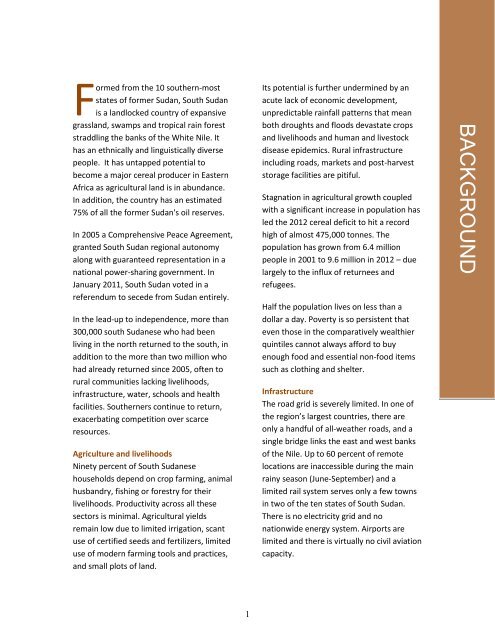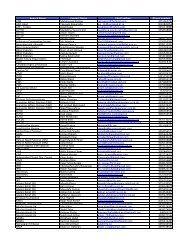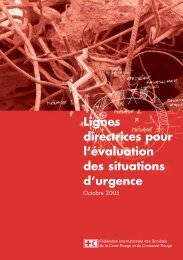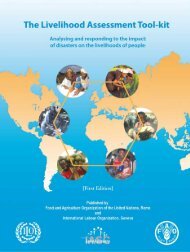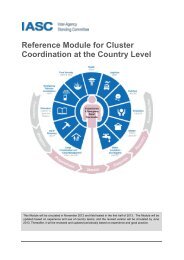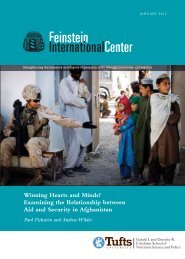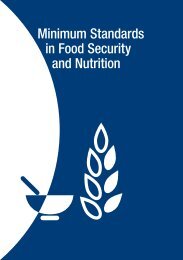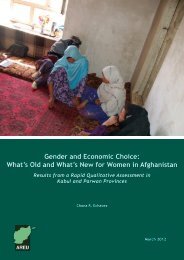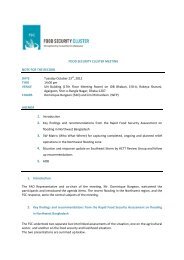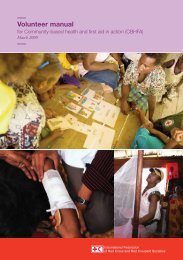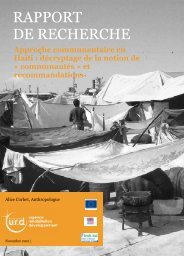4.15 MB - Food Security Clusters
4.15 MB - Food Security Clusters
4.15 MB - Food Security Clusters
- No tags were found...
You also want an ePaper? Increase the reach of your titles
YUMPU automatically turns print PDFs into web optimized ePapers that Google loves.
BACKGROUND<strong>Food</strong> <strong>Security</strong> backgroundFormed from the 10 southern-moststates of former Sudan, South Sudanis a landlocked country of expansivegrassland, swamps and tropical rain foreststraddling the banks of the White Nile. Ithas an ethnically and linguistically diversepeople. It has untapped potential tobecome a major cereal producer in EasternAfrica as agricultural land is in abundance.In addition, the country has an estimated75% of all the former Sudan's oil reserves.In 2005 a Comprehensive Peace Agreement,granted South Sudan regional autonomyalong with guaranteed representation in anational power-sharing government. InJanuary 2011, South Sudan voted in areferendum to secede from Sudan entirely.In the lead-up to independence, more than300,000 south Sudanese who had beenliving in the north returned to the south, inaddition to the more than two million whohad already returned since 2005, often torural communities lacking livelihoods,infrastructure, water, schools and healthfacilities. Southerners continue to return,exacerbating competition over scarceresources.Agriculture and livelihoodsNinety percent of South Sudanesehouseholds depend on crop farming, animalhusbandry, fishing or forestry for theirlivelihoods. Productivity across all thesesectors is minimal. Agricultural yieldsremain low due to limited irrigation, scantuse of certified seeds and fertilizers, limiteduse of modern farming tools and practices,and small plots of land.Its potential is further undermined by anacute lack of economic development,unpredictable rainfall patterns that meanboth droughts and floods devastate cropsand livelihoods and human and livestockdisease epidemics. Rural infrastructureincluding roads, markets and post-harveststorage facilities are pitiful.Stagnation in agricultural growth coupledwith a significant increase in population hasled the 2012 cereal deficit to hit a recordhigh of almost 475,000 tonnes. Thepopulation has grown from 6.4 millionpeople in 2001 to 9.6 million in 2012 – duelargely to the influx of returnees andrefugees.Half the population lives on less than adollar a day. Poverty is so persistent thateven those in the comparatively wealthierquintiles cannot always afford to buyenough food and essential non-food itemssuch as clothing and shelter.InfrastructureThe road grid is severely limited. In one ofthe region’s largest countries, there areonly a handful of all-weather roads, and asingle bridge links the east and west banksof the Nile. Up to 60 percent of remotelocations are inaccessible during the mainrainy season (June-September) and alimited rail system serves only a few townsin two of the ten states of South Sudan.There is no electricity grid and nonationwide energy system. Airports arelimited and there is virtually no civil aviationcapacity.1


